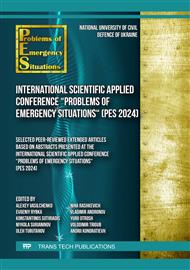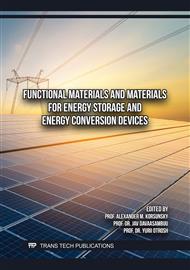[1]
F. Owa, Water Pollution: Sources, Effects, Control and Management, Mediterr. J. Soc. Sci. 4 (2013) 65–68.
Google Scholar
[2]
O.B. Akpor, B. Muchie, Environmental and public health implications of wastewater quality, Afr. J. Biotechnol. 10 (2011) 2379–2387.
Google Scholar
[3]
R.P. Schwarzenbach, T. Egli, T.B. Hofstetter, U. Von Gunten, B. Wehrli, Global Water Pollution and Human Health, Annu. Rev. Environ. Resour. 35 (2010) 109–136.
DOI: 10.1146/annurev-environ-100809-125342
Google Scholar
[4]
R.S. Juang, R.C. Shiau, Metal Removal from Aqueous Solutions Using Chitosan-Enhanced Membrane Filtration, J.Membr. Sci. 165 (2000) 159–167.
DOI: 10.1016/s0376-7388(99)00235-5
Google Scholar
[5]
S. Ahluwalia, D. Goyal, Microbial and Plant Derived Removal of Heavy Metals from Wastewater, Bioresource Technol. J. 98 (2007) 2243–2257.
DOI: 10.1016/j.biortech.2005.12.006
Google Scholar
[6]
M. Malovanyy, I. Bordun, H. Sakalova, A. Blazhko, N. Beznosiuk, Adsorption Purification of Wastewater from Chrome Ions and Phosphate Ions with Bentonite, Key Eng. Mater. 925 (2022) 111–116.
DOI: 10.4028/p-8vmxtc
Google Scholar
[7]
A.G. Sanchez, E.A. Ayuso, Sorption of Zn, Cd and Cr on Calcite: Application to Purification of Industrial Wastewater, Miner. Eng. J. 15 (2002) 539–547.
DOI: 10.1016/s0892-6875(02)00072-9
Google Scholar
[8]
G.T. Tee, X.Y. Gok, W.F. Yong, Adsorption of pollutants in wastewater via biosorbents, nanoparticles and magnetic biosorbents: A review, Environ Res. 212 (2022) 113248.
DOI: 10.1016/j.envres.2022.113248
Google Scholar
[9]
I. Bordun, T. Vasylinych, M. Malovanyy, H. Sakalova, L. Liubchak, L. Luczyt, Study of adsorption of differently charged dyes by carbon adsorbents, Desalin. Water Treat. 288 (2023) 151–158.
DOI: 10.5004/dwt.2023.29332
Google Scholar
[10]
N. Jaafarzadeh, B. Kakavandi, A. Takdastan, Powder activated carbon/Fe3O4 hybrid composite as a highly efficient heterogeneous catalyst for Fenton oxidation of tetracycline: degradation mechanism and kinetic, RSC Advances. 5 (2015) 84718–84728.
DOI: 10.1039/c5ra17953j
Google Scholar
[11]
P.M. Godwin, Y. Pan, H. Xiao, M.T. Afzal, Progress in Preparation and Application of Modified Biochar for Improving Heavy Metal Ion Removal From Wastewater, J. Bioresour. Bioprod. 4 (2019) 31–42.
DOI: 10.21967/jbb.v4i1.180
Google Scholar
[12]
P. Gorbyk, N. Kusyak, A. Petranovskaya, E. Oranskaya, N. Abramov, N. Opanashchuk, Synthesis and properties of magnetic nanostructures with carbonized surface, Himia, Fizika ta Tehnologia Poverhni. 9 (2018) 176–189. (In Ukrainian)
DOI: 10.15407/hftp09.02.176
Google Scholar
[13]
H.M.A. Ghany, Production of a new activated carbon prepared from palm fronds by thermal activation, Int. J. Eng. Tech. Mgmt. Res. 6 (2019) 34–43.
DOI: 10.29121/ijetmr.v6.i4.2019.368
Google Scholar
[14]
V. Ptashnyk, I. Bordun, E. Szymczykiewicz, M. Malovanyy, The investigation of the structure of biocarbon synthesized from wheat straw after weakly concentrated phosphoric acid pretreatment, Appl. Nanosci. 13 (2023) 4883–4890.
DOI: 10.1007/s13204-022-02641-0
Google Scholar
[15]
J.A. Abudaia, M.O. Sulyman, K.Y. El-Azaby, S.M. Ben-Ali, Adsorption of Pb(II) and Cu(II) from Aqueous Solution onto Activated Carbon Prepared from Date Stones, Int. J. Environ. Sci. Dev. 4 (2013) 191–195.
DOI: 10.7763/ijesd.2013.v4.333
Google Scholar
[16]
A.H. El-Sheikh, A.P. Newman, H.K. Al-Daffaee, S. Phull, N. Cresswell, Characterization of Activated Carbon Prepared from a Single Cultivar of Jordanian Olive Stones by Chemical and Physicochemical Techniques, J. Anal. Appl. Pyrolysis. 71 (2004) 151–164.
DOI: 10.1016/s0165-2370(03)00061-5
Google Scholar
[17]
R.M. Rafie, Removal of Heavy Metals from Waste Water Using Black Tea Waste, Arab. J. Sci Eng. 37 (2012) 1505–1520.
DOI: 10.1007/s13369-012-0264-8
Google Scholar
[18]
A.C.F. Alves, R.V.P. Antero, S.B. de Oliveira, S.A. Ojala, P.S. Scalize, Activated carbon produced from waste coffee grounds for an effective removal of bisphenol-A in aqueous medium. Environ. Sci. Pollut. Res. 26 (2019) 24850–24862.
DOI: 10.1007/s11356-019-05717-7
Google Scholar
[19]
K.Y. Foo, B.H. Hameed, Utilization of rice husks as a feedstock for preparation of activated carbon by microweve induced KOH and K2CO3 activation, Bioresour. Technol. 102 (2011) 9814–9817.
DOI: 10.1016/j.biortech.2011.07.102
Google Scholar
[20]
Ch. Soloviy, M. Malovanyy, I. Bordun, F. Ivashchyshyn, A. Borysiuk, Yu. Kulyk, Structural, magnetic and adsorption characteristics of magnetically susceptible carbon sorbents based on natural raw materials, J. Water Land Dev. 47 (2020) 160–168.
DOI: 10.24425/jwld.2020.135043
Google Scholar
[21]
Q. Zhao, T. Xu, X. Song, S. Nie, S.-E. Choi, C. Si, Preparation and Application in Water Treatment of Magnetic Biochar, Front. Bioeng. Biotechnol. 9 (2021) 769667.
DOI: 10.3389/fbioe.2021.769667
Google Scholar
[22]
L.Zh. Lee, M.A.A. Zaini, One-step ZnCl2/FeCl3 composites preparation of magnetic activated carbon for effective adsorption of rhodamine B dye, Toxin Rev. 41 (2022) 64–81.
DOI: 10.1080/15569543.2020.1837172
Google Scholar
[23]
Y. Luo, L. Zeng, Y. Zhao, Zh. Zhao, M. Wei, B. Jiang, J. Fan, D. Li, Roles of ZnCl2 and FeCl3 in preparing high performance corn stover-based carbon materials for efficient removal of Cr (VI) from wastewater, J. Water Proc. Engineering. 47 (2022) 102743.
DOI: 10.1016/j.jwpe.2022.102743
Google Scholar
[24]
Z.A. Duryagina, R.L. Holyaka, A.K. Borysyuk, The Automated Wide-Range Magnetometer for the Magnetic Phase Analysis of Alloys: Development and Application, Usp. Fiz. Met. 14 (2013) 33–66. (In Ukrainian)
DOI: 10.15407/ufm.14.01.033
Google Scholar
[25]
M. Thommes, K. Kaneko, A. Neimark, J. Rodriguez-Reinoso, J. Rouquerol, K. Sing, Physisorption of gases, with special reference to the evaluation of surface area and pore size distribution (IUPAC Technical Report), Pure Appl. Chem. 87 (2015) 1051–1069.
DOI: 10.1515/pac-2014-1117
Google Scholar
[26]
J. Rouquerol, F. Rouquerol, P. Llewellyn, G. Maurin, K. Sing, Adsorption by powders and porous solids: principles, methodology and applications, second ed. Elsevier / Academic press, Oxford, 2012.
DOI: 10.1016/b978-0-08-097035-6.00001-2
Google Scholar
[27]
J. Rouquerol, P. Llewellyn, F. Rouquerol, Is the BET equation applicable to microporous adsorbents?, in: Characterization of Porous Solids VII. P. Lewellyn, F. Rodriguez-Reinoso, J. Rouquerol, N. Seaton (Eds). Stud. Surf. Sci. Catal. 160 (2002) 49–56.
DOI: 10.1016/s0167-2991(07)80008-5
Google Scholar
[28]
J.M.D. Coey, Magnetism and Magnetic Materials, Cambridge University Press, Cambridge, 2010.
Google Scholar
[29]
M.D. Nguyen, H.V. Tran, S. Xu, T.R. Lee, Fe3O4 Nanoparticles: Structures, synthesis, magnetic properties, surface functionalization, and emerging applications, Appl. Sci. 11 (2021) 11301.
DOI: 10.3390/app112311301
Google Scholar
[30]
A.G. Kolhatkar, A.C. Jamison, D. Litvinov, R.C. Willson, T.R. Lee, Tuning the magnetic properties of nanoparticles. Int. J. Mol. Sci. 14 (2013) 15977–16009.
DOI: 10.3390/ijms140815977
Google Scholar
[31]
K.M. Krishnan, Biomedical nanomagnetics: a spin through possibilities in imaging, diagnostics, and therapy, IEEE Trans. Magn. 46 (2010) 2523–2558.
DOI: 10.1109/tmag.2010.2046907
Google Scholar
[32]
Q. Lі, Ch.W. Kartikowati, S. Horie, T. Ogi, T. Iwaki, K. Okuyama, Correlation between particle size/domain structure and magnetic properties of highly crystalline Fe3O4 nanoparticles, Sci. Rep. 7 (2017) 1–7.
DOI: 10.1038/s41598-017-09897-5
Google Scholar



